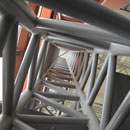Architecturally Exposed Structural Steel
The AESS Categories - AESS1 - Basic Elements
AESS 1 – Basic Elements is the first step above Standard Structural Steel. This type of application would be suitable for "basic" elements, which require enhanced workmanship. This type of exposed structure could be found in roof trusses for arenas, warehouses, big box stores and canopies and should only require a low cost premium in the range of 20% to 60% due to its relatively large viewing distance as well as the lower profile nature of the architectural spaces in which it is used.
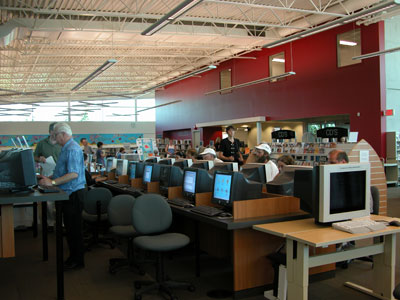 |
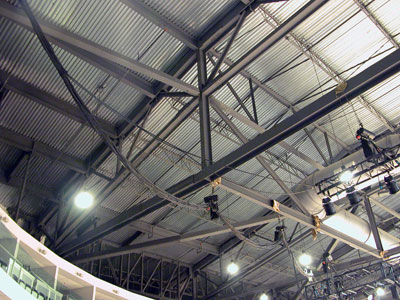 |
Semiahmoo Library, Surrey, B.C.: The project uses a very simple exposed structure comprised of W sections and OWSJ with a painted finish. Some extra care is necessary, in keeping with the library use of the facility, in the preparation and installation of the structure. The W sections are exposed to view and touch, but overall the ceiling elements are viewed at a distance. Had this project used custom trusses instead of OWSJ members, it would likely have fallen into AESS 2 Category Steel. In the case of the Library, the steel has been left exposed to save on the use of finish material, which has helped in achieving credits towards a LEED Silver Rating. (lower cost premium with standard joists) |
Ricoh Centre, Toronto, ON: Although the trusses that span the arena proper in the Ricoh Centre are somewhat closer to view, they fall into AESS 1 given their more roughly detailed design style as well as the less refined nature of the space. (low cost premium through the use of standard sections and connections that are removed from view). There is still signicant extra fabrication cost over the use of some simpler, prefabrication systems such as OWSJ. Hence the range in premium that can be seen in AESS1 steel. |
AESS 1 applications will see the use of fairly straightforward section types such as W, HSS, and often OWSJ and exposed profiled decking. Generally this type of framing might appear similar to basic structural steel applications, other than the fact that it is left exposed to view. Because it is left exposed to view, more care is required to ensure that the standard structural members are aligned in a uniform way, that spacing is kept consistent, and that the surfaces of the members are properly prepared to accept uniform finishes and coatings. A greater level of consistency in the use of connections, bolts, and welds is also required.
These types of applications may or may not require special fire protection design. This is determined as a function of the use of the space. In some situations the steel may be left completely unprotected, or sprinklered, and so it will need to receive only a paint finish. Intumescent coatings could be found where the rating would be one hour or greater, however this might not be a common choice due to the cost of the coating system. The detailing on AESS 1 elements should not be greatly impacted by the relative thickness or finish of the intumescent coating as much of this type of steel will be located well above eye level and out of range of touch.
As it is anticipated that many AESS projects will specify more than one Category of steel, it will be common to specify AESS 1 for the ceiling elements of a design, where the distance to view is in the 6 m or greater range, and use a different class of AESS for those elements, like columns, that are located at a closer proximity.
Alternatively some specialty custom designed steel may be specified, but would be located at a distant view so that the fabrication, finish of the steel and workmanship would not come under close scrutiny. Some of these specialty fabrications will be similar to those used in AESS 2, with the distance factor being the major point of separation.
Another factor that will impact the decision to ask for AESS 1 versus AESS 2 steel for an exposed ceiling will be the nature of the lighting. In the case of Semiahmoo Library, the light level on the ceiling is high, and the ceiling height at the low range for this category. In the Ricoh Centre, the steel is more articulated, using curved shapes and HSS members, but the ceiling is extremely high, and the lighting levels in the low range and additionally using a type of lighting that tends to conceal detail. If the curved steel trusses of the Ricoh Centre were to be brightly uplit with a more blue white type of light that could accentuate the detail, this structure might need to fall into a higher Category.
Also important to consider when specifying AESS 1 for the ceiling will be the nature of the other elements and systems that will be incorporated into the ceiling plane. Is it "busy" with mechanical services? Do these need to run parallel or perpendicular to the main structural lines of the trusses or joists? Are the services to be painted "out" or accentuated? Typically you will see sprinkler runs and HVAC equipment integrated into most AESS 1 type ceilings. In the case of retail (Big Box) stores, you might also see a high level of signage that will serve to take the focus away from the steel systems and therefore allow for a lower level of finish and detailing.
Depending on the environment (moisture level in the case of rinks and chemicals in the case of swimming pools, industrial plants, etc.) this type of steel may need special coating treatment to prevent corrosion. This will impact the overall cost of the installation.
AESS1 - Characteristics
A set of Characteristics is associated with each Category. Higher-level Categories include all of the Characteristics of the preceding Categories, plus a more stringent set of additional requirements. The Characteristics listed below form the basis for differentiation of the AESS Categories and are listed in this order in the Matrix. It is suggested that when using the Suite of AESS Documents that all of the Characteristics associated with each of the Categories be included in the contractual arrangements. For clarity, visual references in the form of steel samples (courtesy of the American Institute of Steel Construction) have been included in the ensuing descriptions. This Guide also includes visual references in the built context to assist in clarifying the intention of each bulleted point.
AESS 1 fabrication and erection specifications would include Characteristics 1.1 to 1.5.
1.1 The surface preparation of the steel must meet SSPC SP-6. Prior to blast cleaning, any deposits of grease or oil are to be removed by solvent cleaning, SSPC SP-1.
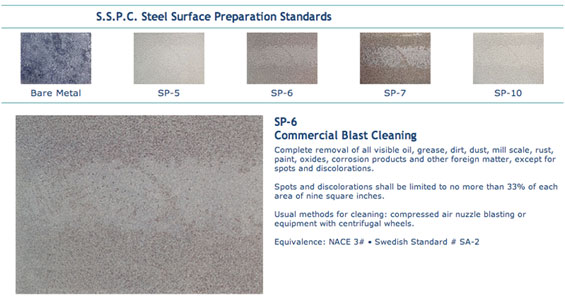 |
| 1.1 Sample sheet showing the finish appearance for Steel Surface Preparation Standards. AESS starts assuming SP-6 finish. Image courtesy of Dry-Tec |
Commercial Blast Cleaning is intended to remove all visible oil, grease, dust, mill scale, rust, paint, oxides, corrosion products and other foreign matter, except for spots and discolorations that are part of the natural steel material. By using this as a starting point, there should not be issues with the application of the range of finishes that would be required for AESS 1 through 4 type applications as these are normally out of immediate eye range due to their typically high locations.
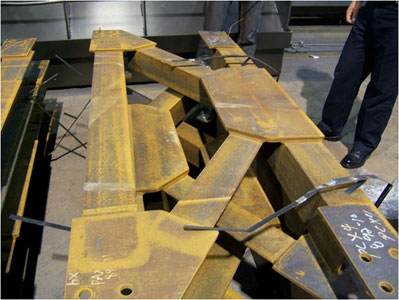 |
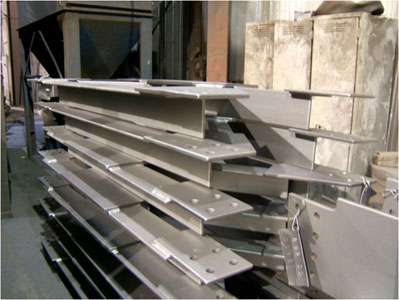 |
As can be seen from the images above, Shot Blast Cleaning can take what may appear to be rusted steel, and transform it into a product that is smooth in finish and ready to receive subsequent treatments and coatings. |
Although this steel is now clean and free from scale and other materials that will prevent proper adhesion of finishes, it will return to a rusted state if left exposed to weather for a period of time. |
It should be noted that one of the alternate Surface Preparation Standards, SP-3, commonly used for structural steel elements, only provides for Power Tool type cleaning and should not be relied upon to provide adequate cleaning for consistent looking finishes in AESS applications.
 |
1.2 Sharp Edges ground smooth Courtesy of AISC |
1.2 All of the sharp edges are to be ground smooth. Rough surfaces are to be de-burred and ground smooth. Sharp edges resulting from flame cutting, grinding and especially shearing are to be softened.Sharp edges, characteristic of standard structural steel, are considered unacceptable in any AESS application. Even if located out of close viewing range, as in AESS 1 type applications, this type of finish condition is not adequate in the final fabrication and installation.
1.3 There should be a continuous weld appearance for all welds. The emphasis here is on the word "appearance". Intermittent welds can be made to look continuous, either with additional welding, caulking or body filler. For corrosive environments, all joints should be seal welded. The seams of hollow structural sections would be acceptable as produced.
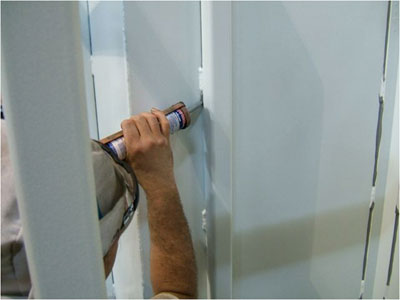 |
1.3 Filling between the intermittent welds to give a continuous weld appearance. |
In many projects fabricators are often asked to create continuous welds when they are structurally unnecessary. This adds extra cost to the project and takes additional time and may create distortions. If not structurally required, the welds themselves need not be continuous. Prior to the application of the final finish, appropriate caulking or filler can be applied between the intermittent welds to complete the appearance. Filling between the intermittent welds also helps in the cleaner application of finishes and prevents the build up of dirt in the joints that can be problematic to clean. Care should be taken in the application of fill materials to ensure that the surfaces beneath are clean to ensure adherence and that the compounds are compatible with the type of finish application.
1.4 It is assumed that bolted connections will use standard structural bolts. When bolting, the heads should all be located on one side of the connection, but they need not be fastidiously aligned. There should also be consistency from connection to connection.
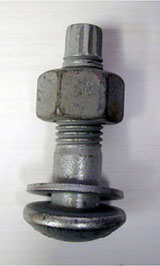 |
 |
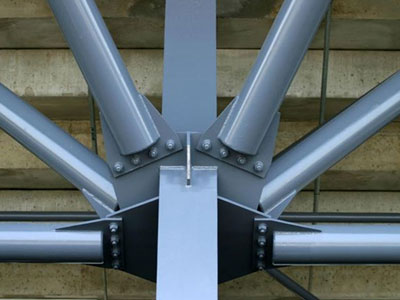 |
1.4 Standard Structural bolt components include the TC (tension control) Bolt as well as the Hex Head Bolt |
Standard Structural bolt alignment will vary for tightening. It is not possible to ask for alignment of orientation of the bolts or heads as this could negatively impact strength. |
Standard Structural bolts carefully aligned with nuts all facing the same direction is a very reasonable expectation for installation and assists in elevating the aesthetic of even the simplest details. |
This characteristic requires that some additional care be given when erecting the structure. It is reasonable to expect that all of the bolt heads should be positioned on the same side of a given connection, and that all such connections be treated in a similar manner so that the look of the overall structure is consistent. It is NOT reasonable to expect that the bolts should be tightened so that the heads are aligned identically. The structural tightening of the bolts must take priority.
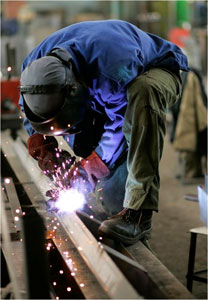 |
1.5 Natural splatter due to the weld process to be removed |
1.5 Weld splatters, slivers, surface discontinuities are to be removed as these will mar the surface and it is likely that they will show through the final coating. Weld projection up to 2 mm is acceptable for butt and plug welded joints.
This expectation would hold for both procedures carried out in the fabrication shop prior to erection as well as weld splatter and surface continuities that might happen during or as a result of erection. Such a case would be following the removal of temporary steel supports or shoring elements that have been used to facilitate the erection process. When these elements are removed the marred surfaces should be properly repaired, and any oxidized surfaces repaired prior to final finish applications.
It was decided to include ALL weld splatter removal so to avoid potential conflict in deciding on the minimum diameter or intensity of splatter to be removed.
